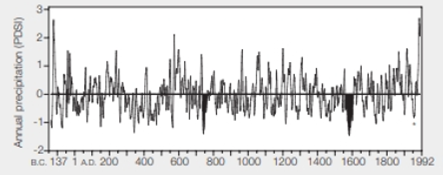
Tree Rings Reveal Droughts El Malpais National Monument, in west central New Mexico, has pockets of vegetation that have been surrounded by lava fields for about 3,000 years, so they have escaped wildfires, grazing animals, agricultural activity, and logging. Henri Grissino-Mayer generated a 2,129-year annual precipitation record using tree ring data from living and dead trees in this park (FIGURE 27.22).

FIGURE 27.22 Annual precipitation record for 2,129 years, inferred from compiled tree ring data in El Malpais National Monument, New Mexico. Data were averaged over 10-year intervals; the graph correlates with other indicators of rainfall collected in all parts of North America. PDSI, Palmer Drought Severity Index: 0, normal rainfall; increasing numbers mean increasing excess of rainfall; decreasing numbers mean increasing severity of drought.
* A severe drougt contributed to a series of catastrophic dust storms that turned the midwestern United States into a "dust bowl" between 1933 and 1939.
Around a.d.770, the Mayan civilization began to suffer a massive population loss, particularly in the southern lowlands of Mesoamerica. The El Malpais tree ring data show a drought during that time. Was it more or less severe than the Dust Bowl drought in 1933–1939?
To determine: Whether the drought at A.D. 770 was more or less severe than the Dust Bowl drought in 1933-1939.
Concept introduction: Tree rings are the number of concentric rings in the cross section of the tree trunks that represent a single year growth. Tree ring dating is done to find the exact year of their formation. Tree ring dating helps to analyze the atmospheric condition during the different periods in history. The researchers have created the record of drought dating back hundreds to thousands of years by using tree rings.
Explanation of Solution
The Mayan civilization suffers a massive population loss in the 770 AD. Between 1933 and 1939, a severe drought contributed to the series of the catastrophic dust storms that turned the Midwestern Unites States into a dust bowl. From the data, there is a point that extends to about -1.5 PDSI at 770 A.D. It indicates a severe drought. The dust bowl drought which is indicated by a * on the graph has a PDSI of about -1. Comparing to the drought at 770 A.D. it was more severe than the dust bowl.
The drought in the 770 A.D. was more severe than the drought during the dust bowl.
Want to see more full solutions like this?
Chapter 27 Solutions
Biology: The Unity and Diversity of Life (MindTap Course List)
Additional Science Textbook Solutions
Genetics: From Genes to Genomes
Campbell Essential Biology (7th Edition)
HUMAN ANATOMY
Chemistry: Atoms First
Cosmic Perspective Fundamentals
- Describe two different gene regulation mechanisms involving methylationarrow_forwardWhat is behavioral adaptarrow_forward22. Which of the following mutant proteins is expected to have a dominant negative effect when over- expressed in normal cells? a. mutant PI3-kinase that lacks the SH2 domain but retains the kinase function b. mutant Grb2 protein that cannot bind to RTK c. mutant RTK that lacks the extracellular domain d. mutant PDK that has the PH domain but lost the kinase function e. all of the abovearrow_forward
- Explain how the hormones of the glands listed below travel around the body to target organs and tissues : Pituitary gland Hypothalamus Thyroid Parathyroid Adrenal Pineal Pancreas(islets of langerhans) Gonads (testes and ovaries) Placentaarrow_forwardWhat are the functions of the hormones produced in the glands listed below: Pituitary gland Hypothalamus Thyroid Parathyroid Adrenal Pineal Pancreas(islets of langerhans) Gonads (testes and ovaries) Placentaarrow_forwardDescribe the hormones produced in the glands listed below: Pituitary gland Hypothalamus Thyroid Parathyroid Adrenal Pineal Pancreas(islets of langerhans) Gonads (testes and ovaries) Placentaarrow_forward
 Biology: The Unity and Diversity of Life (MindTap...BiologyISBN:9781305073951Author:Cecie Starr, Ralph Taggart, Christine Evers, Lisa StarrPublisher:Cengage Learning
Biology: The Unity and Diversity of Life (MindTap...BiologyISBN:9781305073951Author:Cecie Starr, Ralph Taggart, Christine Evers, Lisa StarrPublisher:Cengage Learning Biology: The Unity and Diversity of Life (MindTap...BiologyISBN:9781337408332Author:Cecie Starr, Ralph Taggart, Christine Evers, Lisa StarrPublisher:Cengage Learning
Biology: The Unity and Diversity of Life (MindTap...BiologyISBN:9781337408332Author:Cecie Starr, Ralph Taggart, Christine Evers, Lisa StarrPublisher:Cengage Learning Biology (MindTap Course List)BiologyISBN:9781337392938Author:Eldra Solomon, Charles Martin, Diana W. Martin, Linda R. BergPublisher:Cengage Learning
Biology (MindTap Course List)BiologyISBN:9781337392938Author:Eldra Solomon, Charles Martin, Diana W. Martin, Linda R. BergPublisher:Cengage Learning Biology: The Dynamic Science (MindTap Course List)BiologyISBN:9781305389892Author:Peter J. Russell, Paul E. Hertz, Beverly McMillanPublisher:Cengage Learning
Biology: The Dynamic Science (MindTap Course List)BiologyISBN:9781305389892Author:Peter J. Russell, Paul E. Hertz, Beverly McMillanPublisher:Cengage Learning Human Biology (MindTap Course List)BiologyISBN:9781305112100Author:Cecie Starr, Beverly McMillanPublisher:Cengage Learning
Human Biology (MindTap Course List)BiologyISBN:9781305112100Author:Cecie Starr, Beverly McMillanPublisher:Cengage Learning Biology 2eBiologyISBN:9781947172517Author:Matthew Douglas, Jung Choi, Mary Ann ClarkPublisher:OpenStax
Biology 2eBiologyISBN:9781947172517Author:Matthew Douglas, Jung Choi, Mary Ann ClarkPublisher:OpenStax





